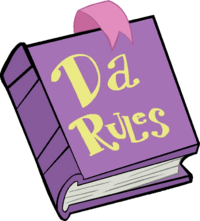Powers
Before the game
During the game
Tossups with power have a set of early clues where a buzz with the correct answer is worth extra points. Powers serve to reward deep knowledge of a subject more than basic knowledge.
The region of a question which is worth additional points is referred to as "in power"; the remainder is "out of power".
The verb "to power" means to answer a tossup correctly within power. For example, "They just powered that tossup on Lysistrata."
Appearance
The portion of a tossup in power is typically referred to two ways:
- The text is in bold
- It lies before the power mark, which typically an asterisk in parentheses: "(*)"
In the modern game questions usually use both of these methods, but older questions may use only one. Sets with open powers (e.g. The World As It Is, NSC pre-2010) sometimes choose to omit markings entirely as they are not necessary to determine if a buzz was in power.
During the production of question sets, power-marking is the editorial process of deciding where to place power marks in tossups.
A question set whose tossups contain powers is called power-marked.
In this example tossup, all the text in bold is worth 15 points and all the text afterward is worth 10 points:
This figure’s sister relieves her boredom by taking a Latin course by correspondence in a friend’s name. Elizabeth, or “Bep,” brings this figure books from the library every Saturday. This figure has a crush on Peter Schiff, but later transposes that affection onto Peter van Daan. She lives in the (*) “Secret Annex” with her father Otto, but their location is betrayed in August, 1944. For 10 points, name this Jewish girl whose Diary of a Young Girl was published as a Holocaust narrative.
ANSWER: Anne Frank
(from HSAPQ Tournament-22)
Theory
Power theory varies and is not well developed.
Power marks are usually placed around halfway into a tossup. In some implementations, powers may be intended to reward approximately the top quartile or quintile of players.
Power marks are not placed entirely arbitrarily; they are usually placed directly before substantially new information (usually a noun, title, etc.) that is a step easier than previous information.
In most formats with powers, they are usually worth 15 points. (In some formats, they are worth 20 points.)
Incidence
All of ACF's question sets do not use powers. However, the common modified ACF format does incorporate powers and is the most common choice of rules for housewrites at all levels of the game.
All NAQT-format sets use tossups with 15-point powers. NAQT sets were the first widely played sets to use powers (see #History).
Since 2010, all tossups at the PACE NSC have had powers, which are worth 20 points.
Variants
Super-powers
Some formats have both powers and super-powers (or superpowers), which form a second tier of rewarding early correct buzzes, and are usually worth 20 points.
The Experiment pioneered the use of super-powers. They have also appeared in various other side events like Gaddis and CANONEXPANSION.
The final quarter of a round of National History Bowl features tossups with three tiers: 30-point superpowers, 20-point powers, and 10-point regular clues.
Blind and open powers
There are two types of power:
- blind powers, in which the power mark is unknown to any player on either team
- open powers, in which the power mark is known to all players
Most tournaments with powers use "blind" powers.
The "stretch round" of the old PACE format used 20-point open powers, in which power always ends as the words "For 10 points" are read (before the giveaway). In 2021, The World As It Is used this same format.
Power vulch
Powers create a particular vulching opportunity called a power vulch, in which a player buzzes in immediately after the opposing team negs, in the hopes of getting the additional reward.
As with any vulching, it is looked down upon to not wait until the end of a tossup after a neg. Power-vulching is usually a sign of a player padding their PPG. There are some narrow situations where power-vulching becomes strategically favorable without being dubious (e.g.: trying to make a comeback when few points are left in the game, playing fast on the clock).
History
According to posts on the Usenet group, the idea for the power tossup was proposed by Tom Waters at some point possibly as far back as 1989. (In a comment on a Facebook post by Patrick Matthews, Waters attributed the idea to an unknown Emory team member circa 1979.) At its first implementation, the 1996 SCT, only certain tossups had power marks available; others were only worth 10 points throughout. This idea was abandoned, possibly as early as the 1997 ICT, and the use of standardized powers for the entire set became expected in tournaments which chose to use powers.
"FIFTEEEEEEEEEEN!"
It was once common for jerks to sarcastically say "FIFTEEEEEEEEEEN!" when a player earned power for buzzing on a famous clue. This is now strongly frowned upon and makes the utterer look bad.
This was invented at Michigan practices around 2005 and quickly spread to other teams. Audience member Leo Wolpert's announcements of "FIFTEEEENNN!" were audible whenever a question was powered in the 2006 ICT finals. Ian Eppler can be heard shouting it during the 2008 HSNCT playoffs at this recording. Oddly, Guy Tabachnick, who did exactly the same thing at the same time, cannot be heard.
